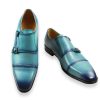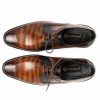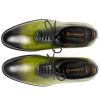Introduction
When you invest in a quality pair of leather shoes, you want more than just style—you want comfort, durability, and a fit that feels tailor-made. That’s where hand-lasted shoes shine. Unlike mass-produced footwear, hand-lasted pairs are painstakingly shaped by skilled artisans who stretch and secure the leather over a mold (called a “last”) using only hand tools. In this guide, you’ll discover what makes hand-lasting special, why it benefits you as the wearer, and how to recognize (and care for) truly hand-lasted shoes that will serve you for years.
1. What Does “Hand Lasted” Mean?
Simply put, hand-lasting is the process of pulling, shaping, and tacking the leather upper onto a foot-shaped form by hand. No hydraulic presses, no automated clamps—only craftsmanship. Each shoe undergoes precise, hands-on tensioning, ensuring the leather conforms exactly to the last’s curves. The result? A more personalized fit, fewer wrinkles in the leather, and a silhouette that follows your foot’s natural shape.
-
Artisan’s Touch: An experienced cobbler works with lasting pliers (wide-jawed tools) and hundreds of tiny nails (“lasting tacks”) to mold the upper around the last.
-
Customized Tension: Rather than a one-size-fits-all machine setting, the artisan adjusts pull strength and tack placement based on the leather’s thickness, grain, and the last’s shape.
2. Why Hand-Lasted Shoes Feel Better
2.1 Superior Fit and Comfort
-
True-to-Last Shape: Because the leather is stretched and smoothed by hand, you get a precise fit from heel to toe. No puckering, no stray folds—just a consistent, glove-like feel.
-
Break-In Is Easier: Hand-lasted shoes conform more naturally to your foot as you wear them. Rather than forcing stiff leather into shape, the leather relaxes evenly, reducing pinch points and hot spots.
2.2 Enhanced Durability
-
Less Stress on Leather: Machines can overburden delicate areas, creating weak spots that may crack or tear later. Hand-last methods distribute tension evenly, preserving the leather’s integrity.
-
Stronger Construction: Hand-lasting allows for snug, secure stitching and insole attachment—so soles and uppers stay put longer. You’ll find that properly hand-lasted pairs often outlive machine-lasted alternatives.
2.3 Timeless Aesthetic
-
Natural Grain Flow: When a cobbler guides the leather grain by hand, the shoe displays an organic, elegant drape. You’ll notice subtle curves and smooth lines that give hand-lasted shoes their refined look.
-
Unique “Character Marks”: Minor variations—like a single crease that follows a wearer’s specific last shape—don’t signal sloppiness. They’re the artisanal signature that makes each pair truly one-of-a-kind.
3. How to Identify Hand-Lasted Shoes
3.1 Inspect the Lasting Area (Inside the Shoe)
-
If you can gently peel away the insole (or find a removable sock lining), you’ll see where the upper is nailed beneath. Hand-lasting usually shows small, neatly spaced tacks or fine stitching (in the case of “blake stitch” construction).
-
Machine-lasted shoes often have thicker staples or glued layers that look more uniform and industrial. Hand-lasted soles tend to sit flatter against the insole board, without visible bulk.
3.2 Look for Subtle Wrinkle Control
-
On a hand-lasted pair, the toe box and vamp display exceptionally smooth surfaces. Any wrinkles you see will be minimal, flowing in harmony with the last’s contours.
-
Machine-lasted pairs sometimes show slight ripples near seams or under high-stress areas (like across the instep), because the automated equipment doesn’t discriminate leather thickness.
3.3 Check Price Versus Value
-
Hand-lasted shoes typically cost more—often in the mid-hundreds to thousands of dollars—because each pair requires skilled labor. However, if the brand clearly states “hand-lasted construction” (and you can trace the shoemaker’s reputation), you’re paying for longevity, comfort, and that bespoke touch.
4. Benefits Worth the Investment
4.1 One-Year Warranty and Free Resoling
Many high-end brands that offer hand-lasted construction include generous warranties and free or discounted resoling services. When the soles eventually wear down, skilled cobblers can reopen and re-lasten the upper to a new sole, extending the life of your shoes by another decade or more.
4.2 Personalized Break-In Curve
Because the leather was hand-shaped around a specific last, hand-lasted shoes require a shorter break-in period. You’ll notice comfort after just a few wears—compared to machine-lasted alternatives that might remain stiff for weeks.
4.3 Improved Arch Support and Longevity
If you have particular foot concerns—like high arches or a need for custom insoles—hand-lasted pairs adapt beautifully. The firmer, yet flexible, upper provides a stable base for orthotic or padded insoles without compromising the shoe’s intended shape.
5. Care Tips for Hand-Lasted Footwear
5.1 Rotate Your Shoes
-
Give Them Rest: Allow at least 24 hours between wears so moisture evaporates and leather recovers its natural resilience.
-
Use Cedar Shoe Trees: Inserting cedar trees after each wear helps maintain shape, wick away moisture, and prevent odor.
5.2 Clean and Condition Regularly
-
Gentle Cleaning: Wipe off surface dust with a soft brush or damp cloth. Avoid harsh chemicals.
-
Conditioning Routine: Every 6–8 weeks, apply a leather conditioner—focusing on areas that bear the most flex (toe box, vamp)—to keep the grain supple.
-
Polish for Protection: A quality cream polish nourishes the leather, enhances color depth, and adds a light water-resistant barrier.
5.3 Resoling Schedule
-
Check Sole Wear: Inspect the leather or rubber sole’s heel and ball areas every few months. If ridges or worn sections show, it’s time to plan a resole.
-
Choose a Master Cobbler: Always send your hand-lasted shoes back to a cobbler experienced in hand-lasting. They’ll remove old nails, replace the sole, and re-lasten the upper—preserving the shoe’s original fit and feel.
6. Hand-Lasted vs. Machine-Lasted: Which Should You Buy?
While machine-lasted dress shoes certainly fill a gap for budget-friendly or quick-turn purchases, here’s why you might prioritize hand-lasted pairs:
-
You Value Long-Term Comfort Over Initial Savings.
-
Hand-lasted shoes feel better sooner and remain comfortable over years of wear.
-
-
You Appreciate Artisanal Craftsmanship.
-
If you want footwear that has personality—where each stitch and slight contour reflects a human touch—hand-lasted pairs deliver that narrative.
-
-
You Plan to Invest in Closers That Last.
-
High-quality leather and hand construction often justify higher price tags—resoling and minor repairs are more economical than repeating an entire machine-made replacement every couple of years.
-
-
You Have Special Foot Shape or Orthotic Needs.
-
The adaptive fit of hand-lasted shoes makes them ideal for adding custom insoles or accommodating wider instep dimensions.
-
Conclusion
Choosing hand-lasted shoes means choosing footwear that’s alive with craftsmanship. You’ll feel the difference in every step—smoother grain, a nearer-to-foot fit, and the quiet confidence that comes from wearing something made by a human hand, not a machine. While hand-lasted pairs may come with a higher upfront cost, their lasting comfort, timeless aesthetic, and repairability make them an investment in your daily well-being. Next time you shop for leather footwear, look beyond the brand name—seek out the “hand-lasted” label, inspect the interior, and ask questions about construction. Your feet—and your sense of style—will thank you.












